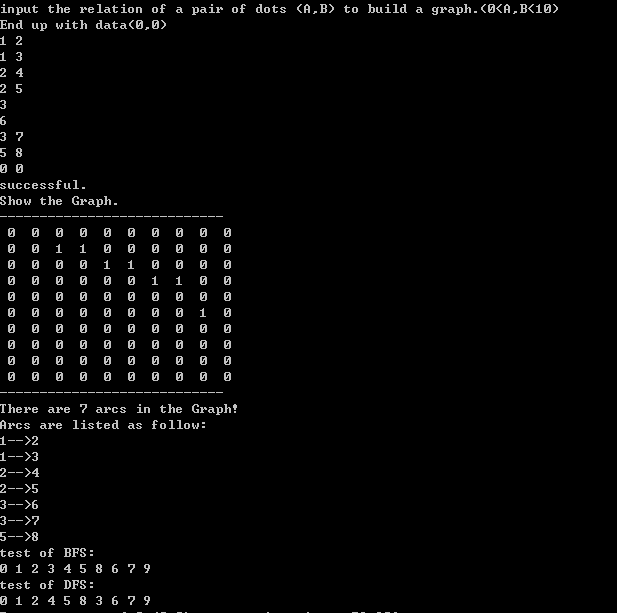15 圖-圖的遍歷-基於鄰接矩陣實現的BFS與DFS算法
阿新 • • 發佈:2017-09-29
namespace 可能 鄰接矩陣 != pre 圖的遍歷 std amp 無法
算法分析和具體步驟解說直接寫在代碼註釋上了
TvT 沒時間了等下還要去洗衣服 就先不贅述了
有不明白的歡迎留言交流!(估計是沒人看的了)
直接上代碼:
1 #include<stdio.h> 2 #include<queue> 3 #include<iostream> 4 using namespace std; 5 typedef struct{ 6 int Vex[10];//頂點表 7 int Edge[10][10]; 8 int vexnum,arcnum; 9 }MGraph; 10 bool visited[10]; 11 void printGraph(MGraph &G) 12 { 13 cout<<"Show the Graph."<<endl; 14 cout<<"----------------------------"<<endl; 15 for(int i=0;i<10;i++){ 16 for(int j=0;j<10;j++) 17 { 18 cout<<" "<<G.Edge[i][j]<<" "; 19 }20 cout<<endl; 21 } 22 cout<<"----------------------------"<<endl; 23 cout<<"There are "<<G.arcnum<<" arcs in the Graph!"<<endl; 24 cout<<"Arcs are listed as follow:"<<endl; 25 for(int i=0;i<10;i++){ 26 for(intj=0;j<10;j++) 27 { 28 if(G.Edge[i][j]==1) 29 cout<<i<<"-->"<<j<<endl; 30 } 31 } 32 } 33 int initGraph(MGraph &G) 34 { 35 G.vexnum=10; 36 G.arcnum=0; 37 for(int i=0;i<10;i++) 38 for(int j=0;j<10;j++) 39 { 40 G.Edge[i][j]=0; 41 } 42 cout<<"input the relation of a pair of dots (A,B) to build a graph.(0<A,B<10)"<<endl; 43 cout<<"End up with data(0,0)"<<endl; 44 int a,b; 45 cin>>a>>b; 46 while(a!=0&&b!=0){ 47 G.arcnum++; 48 G.Edge[a][b]=1; 49 cin>>a>>b; 50 } 51 cout<<"successful."<<endl; 52 printGraph(G); 53 } 54 bool isNeibour(MGraph &G,int a,int b) 55 { 56 if(G.Edge[a][b]==1) 57 return true; 58 else return false; 59 } 60 int firstNeighbor(MGraph &G,int v) 61 { 62 int pos=-1; 63 for(int i=0;i<G.vexnum;i++) 64 { 65 if((G.Edge[v][i]==1)) 66 {pos=i;break;} 67 } 68 return pos; 69 } 70 int nextNeighbor(MGraph &G,int v,int w) 71 { 72 int pos=-1; 73 for(int i=w+1;i<G.vexnum;i++) 74 { 75 if((G.Edge[v][i]==1)) 76 { 77 pos=i;break; 78 } 79 } 80 return pos; 81 } 82 void visit(int v) 83 { 84 visited[v]=true; 85 cout<<v<<" "; 86 } 87 queue<int> Q; 88 void bfs(MGraph G,int v) 89 { 90 visit(v); 91 Q.push(v); 92 int now; 93 while(!Q.empty()) 94 { 95 now=Q.front(); 96 Q.pop(); 97 for(int w=firstNeighbor(G,now);w>=0;w=nextNeighbor(G,now,w)) 98 { 99 if(!visited[w]) 100 { 101 visit(w); 102 Q.push(now); 103 } 104 } 105 } 106 } 107 void BFS(MGraph &G) 108 { 109 for(int i=0;i<G.vexnum;i++) 110 visited[i]=false; 111 for(int i=0;i<G.vexnum;i++) 112 { 113 if(!visited[i]) 114 bfs(G,i); 115 } 116 } 117 /*DFS 深度優先搜索*/ 118 /*類似於樹的先序遍歷 119 其搜索策略:盡可能【深】地搜索一個圖。 120 遍歷思想: 121 從一個起始頂點v出發,訪問與v鄰接但未被訪問的任一頂點a→繼續訪問a頂點的下一未被訪問的頂點b→……→無法再向下訪問時依次退回到最近被訪問的頂點 122 直到所有頂點都被訪問為止 123 */ 124 void dfs(MGraph &G,int v) 125 { 126 visit(v); 127 int w; 128 for(w=firstNeighbor(G,v);w>=0;w=nextNeighbor(G,v,w)) 129 { 130 if(!visited[w]) 131 { 132 dfs(G,w); 133 } 134 } 135 } 136 void DFS(MGraph &G) 137 { 138 for(int i=0;i<G.vexnum;i++) 139 { 140 visited[i]=false; 141 } 142 for(int i=0;i<G.vexnum;i++) 143 { 144 if(!visited[i]) 145 dfs(G,i); 146 } 147 } 148 int main() 149 { 150 MGraph P; 151 initGraph(P); 152 cout<<"test of BFS:"<<endl; 153 BFS(P); 154 cout<<endl; 155 cout<<"test of DFS:"<<endl; 156 DFS(P); 157 return 0; 158 }
附一張運行截圖

15 圖-圖的遍歷-基於鄰接矩陣實現的BFS與DFS算法
